
|
NOTE: You are viewing the OLD VeloceToday website. We are in the process of moving some of the old articles from the OLD site to the NEW site.
|

|

|

|


Home
Cars
Racing
News
People
Lifestyle
Events

|

|

|
People
|

|

|
Count Felice Trossi

|
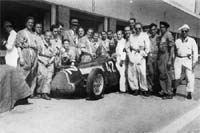 Tripoli, 1940. Count Trossi is in the dark glasses and Meo Constantini, as team manager, in the hat and tie on the left. Credit: Alfa Romeo View larger image.
Tripoli, 1940. Count Trossi is in the dark glasses and Meo Constantini, as team manager, in the hat and tie on the left. Credit: Alfa Romeo View larger image.
| 
|
November 1st, 2002By Ed McDonough
All photos from the collection of Ed McDonough
As the 1940s drew to a close, three of Alfa Romeo’s most talented drivers in the pre or post-war years were all lost to the Milanese company within one year. Forty-four year-old Achille Varzi died in practice for the Grand Prix d’Europe at the Bremgarten circuit at Berne, in Switzerland. His teammates were Jean-Pierre Wimille, Count Trossi, and Consalvo Sanesi. On the 30th of January, 1949, Wimille, then only forty-one, crashed fatally in his Gordini in Buenos Aires. Not long afterwards, Trossi succumbed to cancer in Milan at the age of 44. Alfa Romeo’s non-appearance on Grand Prix racing in 1949 was largely due to this three way blow. Wimille has subsequently been seen as perhaps one of the great drivers of all time, and certainly Fangio thought he was. Varzi’s capacities were widely known, but Trossi remains a relatively vague figure in Alfa Romeo and pre and post-war racing, something of an historical oversight.

|
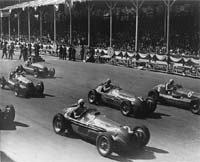 Milan GP, 29-9-46 Varzi in #2, Trossi in #12 Trossi won. Credit: Alfa Romeo View larger image.
Milan GP, 29-9-46 Varzi in #2, Trossi in #12 Trossi won. Credit: Alfa Romeo View larger image.
| 
|
Griff Borgeson’s short profile says he was born at Biela near Vercelli in 1908 and began racing in the late 1920s and gained notice for his driving of a supercharged Mercedes SSK, the car that now belongs to Ralph Lauren and appears at major concours events. In 1932 he started as an Alfa Romeo driver and he and Brivio were 2nd in the Mille Miglia. He won 5 races in 1933 and was 5th at Monaco. Driving the Alfa 158, he won the Italian GP in 1947 and the Swiss in 1948. He was already ill with the cancer that would eventually kill him.

|
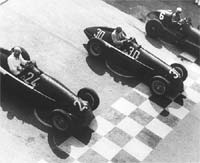 7-9-47 GP di Italia at Milan: Sanesi #24, Trossi #30, and Villoresi in the Maserati #6 Trossi won. Credit: Alfa Romeo View larger image.
7-9-47 GP di Italia at Milan: Sanesi #24, Trossi #30, and Villoresi in the Maserati #6 Trossi won. Credit: Alfa Romeo View larger image.
| 
|
The short biography, however, masks the depths of Trossi’s involvement in racing. In 1932, Vittorio Jano was producing the Alfa Tipo B, or the P3 as it was to become known. While these were being built at Portello, Scuderia Ferrari in Modena saw the resignation of its first president, Caniato, and Enzo Ferrari picked 23 year old Trossi to take the post. This had little to do with Ferrari’s admiration for him as a driver. Trossi was 23, and came from an aristocratic family who had made their wealth in the wool industry and from their ownership of the Banco Sella. He lived in a magnicent castle, the Castello Gaglianico, an hour from Milan by fast car. He was rich and he loved racing, and the fact that he was good was coincidental. He was also a good friend of another minor Italian aristocrat, Marquis Antonio Brivio. Brivio was also talented and the two wealthy men paid for their drives with the Scuderia. Ferrari was happy to have such affluence on the board.

|
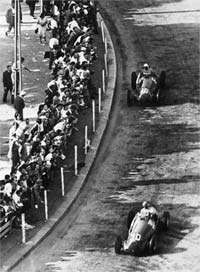 GP d'Italia, Valentines Park, Turin.7-9-47 Here Trossi leads Varzi, but Wimille won. Credit: Alfa Romeo View larger image.
GP d'Italia, Valentines Park, Turin.7-9-47 Here Trossi leads Varzi, but Wimille won. Credit: Alfa Romeo View larger image.
| 
|
Trossi, of course, had the great good or bad fortune, depending on how you look at it, to be racing at the time of the Golden Era giants…Nuvolari, Carraciola, Borzacchini, Varzi, Chiron, Dreyfus, and Raymond Sommer. Trossi was in the 1933 Monaco Grand Prix, said by many to have been the hardest grand prix race of all time, where Nuvolari and Varzi fought tooth and nail the whole distance. Trossi was 5th in the smaller 2.3 Alfa. On Sept.10, 1933 he was at Monza, though this time in his own Duesenberg, a car later raced at Brooklands by Whitney Straight. He had commissioned and paid for this car to be run under the Scuderia Ferrari banner, and as the Gran Premio d’Otalia got underway, Count Czaykowski’s Bugatti T54 led Trossi. Trossi’s Dusenberg stopped with piston failure and reputedly left a trail of oil in Monza’s South Curve. In the second heat, at the end of lap one, Compari and Borzacchini crashed on that oil and were killed. In the final, Czaykowski crashed on the same spot and died in his Bugatti.

|
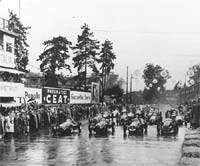 GP d'Italia, Valentines Park, Turin 5-9-48 Trossi is on the left. Wimille won. Credit: Alfa Romeo
View larger image.
GP d'Italia, Valentines Park, Turin 5-9-48 Trossi is on the left. Wimille won. Credit: Alfa Romeo
View larger image.
| 
|
Trossi bore the blame for this for some time, though there were also reports that no oil had leaked from the car, and that the track was damp and the drivers over-exuberant.
At Alessandria in 1934, a few weeks after the Monaco Grand Prix, Nuvolari had the crash that was to keep him out of racing for part of the season. Trossi had been blamed for blocking Nuvolari, though that claim never came from Tazio himself. The young aristocrat seemed to be often in the position of getting the blame. For the Grand Prix de l’ACF at Montlhery, the Scuderia’s three P3s in the hands of Varzi, Chiron and Trossi met the might of the German Mercedes and Auto Union teams. Chiron took the lead, lost it, took it again and after 32 laps, Chiron led from Varzi. Trossi had two gears for many laps, and rather than risk crashing, he came in to hand over to Guy Moll and the Alfas were 1-2-3. As the Alfas fought the German teams at the Nurburgring in July, Trossi was winning the Grand Prix de Vichy in southwest France.
Trossi had numerous pre-war successes and by 1935 was viewed as a mature grand prix and sports car driver, but his health was already showing signs of concern. He regularly appeared in the 12C-37 during 1937, but when Brivio retired, Trossi left ferrari and Alfa and joined Maserati where he had a number of important races in an 8CTF Maserati in 1938. By this time the Alfetta 158 was making its first appearances. Trossi grew disillusioned with Maserati under the Orsis and returned to Alfa Romeo in 1940. As the German invasion of Europe unfolded, the Gran Premio di Triploi saw Trossi in the 158, 3rd behind Farina and Biondetti.
When racing resumed after the war, Trossi reappeared in the single stage supercharger 158 at the Grand Prix de Nations in Geneva. Enzo Ferrari had announced his own plans as a manufacturer and Alfa Romeo were operating on a very small budget. Farina and Trossi managed to get the 158s ahead of Nuvolari’s Maserati and stay there for the second heat. In the final, Farina and Trossi were again 1-2 with Wimille 3rd. Most journals proclaimed that this fantastic race meant that ‘racing was really back!’

|
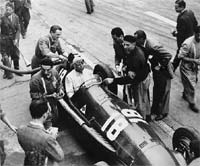 Monza 17-10-48 Guidotti, team manager in the beret, has called in Trossi to see if he can continue. He finished second but this was his last race and he died the following May.Credit: Alfa Romeo View larger image.
Monza 17-10-48 Guidotti, team manager in the beret, has called in Trossi to see if he can continue. He finished second but this was his last race and he died the following May.Credit: Alfa Romeo View larger image.
| 
|
In September, the teams appeared at the Circuito di Milano for two heats and a final. Trossi was now on his best form, and with his characteristic pipe clenched between his teeth, he vanquished Varzi and Sanesi. Not even the great Nuvolari could touch him that day, as the young amateur came of age. At Monza, he won again, leading Varzi home, this time raising his goggles as he crossed the line and lifting his hands from the wheel. The crowd didn’t like it…they thought he was humiliating Varzi.

|
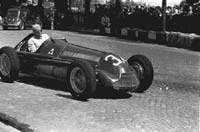 Swiss Grand Prix, June 8th, 1947. Trossi #34 in the 158 Alfa. Credit Author's Collection
View larger image.
Swiss Grand Prix, June 8th, 1947. Trossi #34 in the 158 Alfa. Credit Author's Collection
View larger image.
| 
|
Trossi was on the books again for 1947 but before long Varzi was dead at Berne. Trossi won the race from Wimille. In 1948 Trossi was feeling unwell in the Turin race and dropped back, Sanesi eventually taking over his car. On October 17, the Gran Premio dell Autodromo di Monza was run at Monza with cars for Wimille, Trossi, Sanesi and Taruffi. It was clearly Alfa Corse versus Ferrari and Maserati. Wimille and Trossi fought the Ferraris of Sommer and Farina and Villoresi’s Maserati. Trossi was ill, and Guidotti called him in to see if he was well enough to continue. The graying Trossi, came in, refueled, said he was able to drive, and went out to finish second to Wimille. Three months later, Wimille was gone, and 4 months after that Trossi died in a Milan clinic. He had been a key figure in the rise of Scuderia Ferrari and in the success of the Alfa Romeo 158, though he never achieved public acclaim.
|

|
|

|
|



